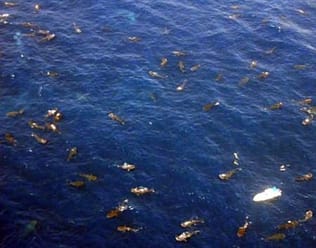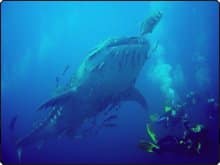Seeing a majestic whale shark while diving is at the top of many divers ‘must do’ lists. So imagine encountering 420 of them!
According to a press release issued by the Smithsonian National Zoological Park, around that number of whale sharks gathered recently off the coast of the Yucatán Peninsula in Mexico.
This is the world’s largest known gathering of the shark and contradicts the belief that the species are solitary creatures. The assembly proves that they will group for reasons such as food.
Mike Maslanka, biologist at the Smithsonian Conservation Biology Institute and head of the Department of Nutrition Sciences, says in the press release “Whale sharks are the largest species of fish in the world, yet they mostly feed on the smallest organisms in the ocean, such as zooplankton. Our research revealed that in this case the hundreds of whale sharks had gathered to feed on dense patches of fish eggs.”
 In spite of their enormous size; they can grow up to 12 metres long and weigh up to 36,000 kilos, whale sharks are docile and move slowly and gracefully through the ocean. They are filter feeders and are often seen gliding with their mouths open ready for food to float in. These majestic sharks occur in all tropical and subtropical ocean regions around the globe.
In spite of their enormous size; they can grow up to 12 metres long and weigh up to 36,000 kilos, whale sharks are docile and move slowly and gracefully through the ocean. They are filter feeders and are often seen gliding with their mouths open ready for food to float in. These majestic sharks occur in all tropical and subtropical ocean regions around the globe.
Maslanka and his team identified the whale shark assembly using both surface and aerial surveys which proved to be a truly amazing sight.
Researchers are calling the gathering the “Afuera” aggregation. During the study, scientists used fine nets to collect food samples in the water around the group of feeding whale sharks. Tests showed that the sought-after fish eggs were from little tunny, a member of the mackerel family, and revealed a previosuly unknown spawning ground for these fish.
 As well as the “Afuera,” the scientists also found another aggregation of whale sharks off the northern tip of the Yucatán Peninsula. Named the Cabo Catoche, this second aggregation was due to the presence of small crustaceans and shrimp. In both groups of sharks the sex ratio was the same suggesting that whole families are drawn to a specific area for feeding purposes.
As well as the “Afuera,” the scientists also found another aggregation of whale sharks off the northern tip of the Yucatán Peninsula. Named the Cabo Catoche, this second aggregation was due to the presence of small crustaceans and shrimp. In both groups of sharks the sex ratio was the same suggesting that whole families are drawn to a specific area for feeding purposes.
This research highlights the need for more concerted conservation efforts in the northeastern Yucatán marine region. With two significant whale shark aggregation areas and at least one active spawning ground for little tunny this is obviously a marine habitat of critical importance.
Whale sharks are listed as “vulnerable” by the International Union for Conservation of Nature, primarily due to harpoon fishing in Southeast Asia and accidental capture by other fishing technologies around the world. You can assist in their protection by taking a liveaboard diving trip or dive resort holiday to observe them in their natural environment. This helps to demonstrate to local governments the enormous economic value of this creature alive not dead.
Click here to watch a video of diving with whale sharks in Thailand.
Would you like to dive with the majestic whale shark? There are several destinations offering this possibility around the world such as the Maldives, Thailand and Lankayan in Malaysia. Contact Dive The World to find out more about diving with whale sharks. You can send us an email or call us on +66 (0)94 582 7973 / (0)83 505 7794.